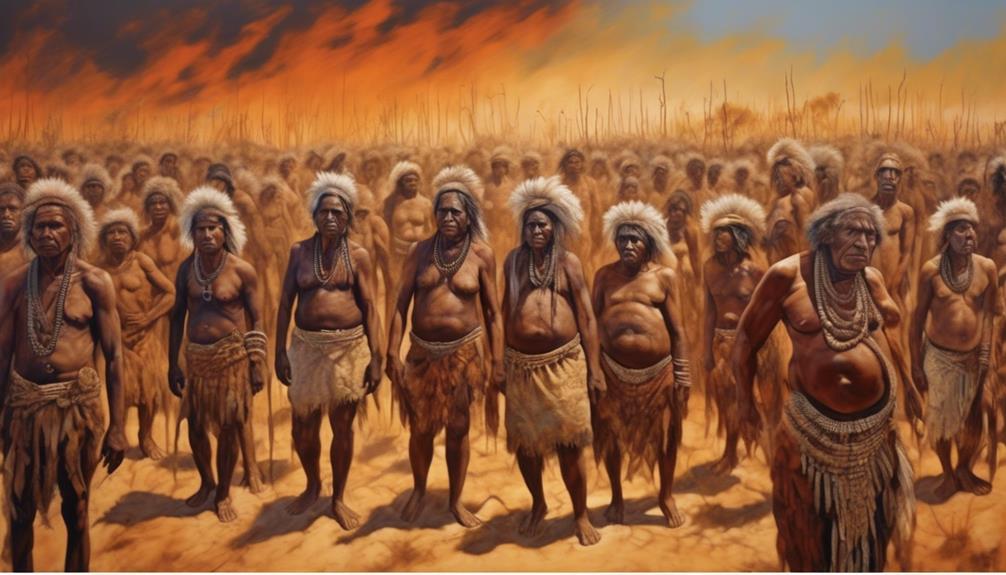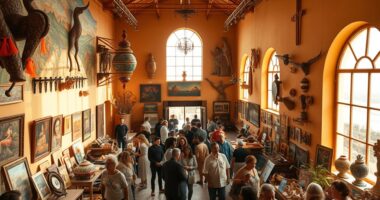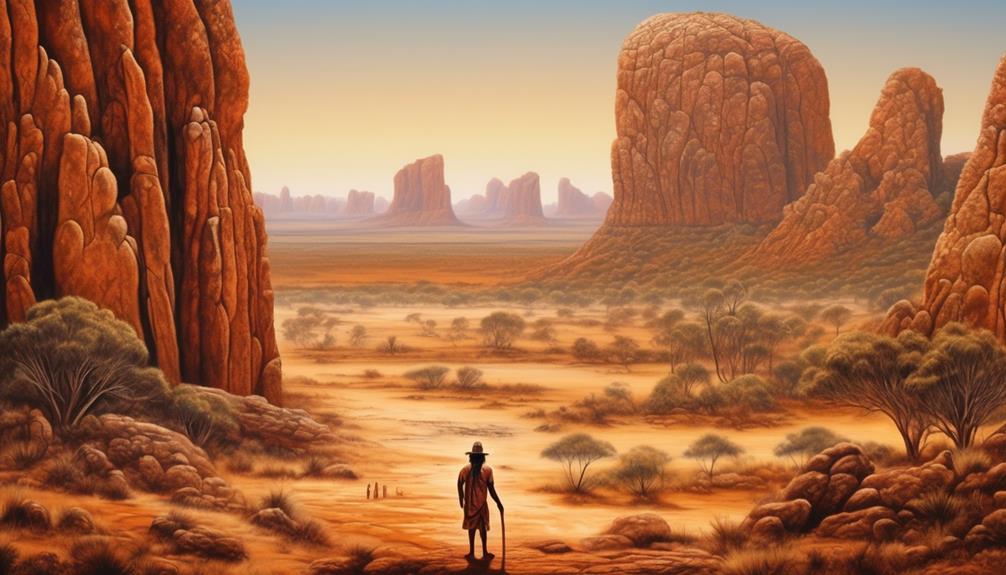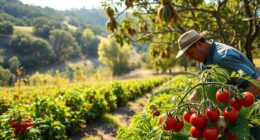Looking back on historical records, the gradual reduction of Aboriginal Australian lands parallels a continuous tide that gradually moves closer to the coast, step by step.
The question of when this process began is a complex and deeply troubling one, stirring a sense of unease as we ponder the pivotal moments that set the stage for the loss of ancestral lands.
From the early encounters with European explorers to the far-reaching impacts of government policies and contemporary land rights movements, the timeline of dispossession is a web of interconnected events that demand our attention and understanding.
Key Takeaways
- Arrival of Europeans led to conflicts and cultural displacement for Aboriginal Australians
- British colonization in 1788 marked the beginning of European invasion and land acquisition
- Government policies implemented to establish reserves for Aboriginal people
- Mining and agriculture have profoundly altered traditional lands of Aboriginal Australians
Early Encounters and Displacement
During the early encounters between European settlers and Aboriginal Australians, displacement became a prevalent and distressing consequence for the Indigenous communities. The arrival of the Europeans led to early conflicts and a profound cultural displacement for the Aboriginal Australians. As the settlers began to establish permanent colonies, they encroached upon the traditional lands of the Indigenous peoples, often disregarding their established territories and sacred sites. This led to a systematic dislocation of the Aboriginal communities from their ancestral lands, disrupting their traditional ways of life and spiritual connections to the land.
The early conflicts between the European settlers and the Aboriginal Australians resulted in a significant loss of autonomy and control over their territories. The imposition of foreign laws and the introduction of unfamiliar concepts of land ownership further marginalized the Indigenous populations, exacerbating their displacement. This cultural displacement not only stripped the Aboriginal Australians of their physical land but also eroded their cultural identity and social cohesion.
Understanding the historical context of these early encounters and the resulting displacement is crucial for facilitating healing and reconciliation. By acknowledging the impact of these events, we can work towards addressing the ongoing repercussions and supporting the rights of Aboriginal Australians to reclaim their cultural heritage and connection to the land.
Colonization and Land Seizures

The European colonization of Australia perpetuated the displacement experienced by Aboriginal Australians, leading to widespread land seizures and further encroachment on Indigenous territories. The arrival of the British in 1788 marked the beginning of European invasion and a systematic process of land acquisition. This colonization significantly impacted Indigenous communities, as their traditional lands were forcibly taken away, disrupting their way of life and connection to country.
| Indigenous Resistance | European Invasion |
|---|---|
| Guerrilla warfare and | The arrival of the British in 1788 marked the beginning of European invasion and a systematic process of land acquisition. This colonization significantly impacted Indigenous communities, as their traditional lands were forcibly taken away. |
| other forms of | |
| resistance were common | |
| among Indigenous | |
| groups. |
Indigenous resistance against the colonization and land seizures was manifested through various forms of protest, including guerrilla warfare and other acts of defiance. However, the sheer force of European invasion and the technological superiority of the colonizers often overwhelmed these resistance efforts. This led to the gradual loss of Indigenous lands and the imposition of European systems of land ownership, further exacerbating the dispossession experienced by Aboriginal Australians.
Government Policies and Reserves
Government policies in Australia have had a significant impact on the allocation and management of reserves for Aboriginal communities.
The history of government policies concerning Aboriginal reserves is complex and has evolved over time. Early encounters between European settlers and Aboriginal communities led to displacement from traditional lands.
In response to this displacement, government policies were implemented to establish reserves for Aboriginal people. These reserves were intended to provide a place for Aboriginal communities to live and maintain their traditional ways of life.
However, the management of these reserves often restricted Aboriginal autonomy and imposed European systems of governance. Additionally, government policies frequently resulted in the reduction of reserve sizes and the forced relocation of Aboriginal communities.
This has led to ongoing challenges in the allocation and management of Aboriginal reserves, as well as disputes over land rights. Understanding the historical context of government policies and their impact on Aboriginal reserves is crucial for addressing the ongoing issues related to land ownership and self-determination for Aboriginal communities.
Impact of Mining and Agriculture
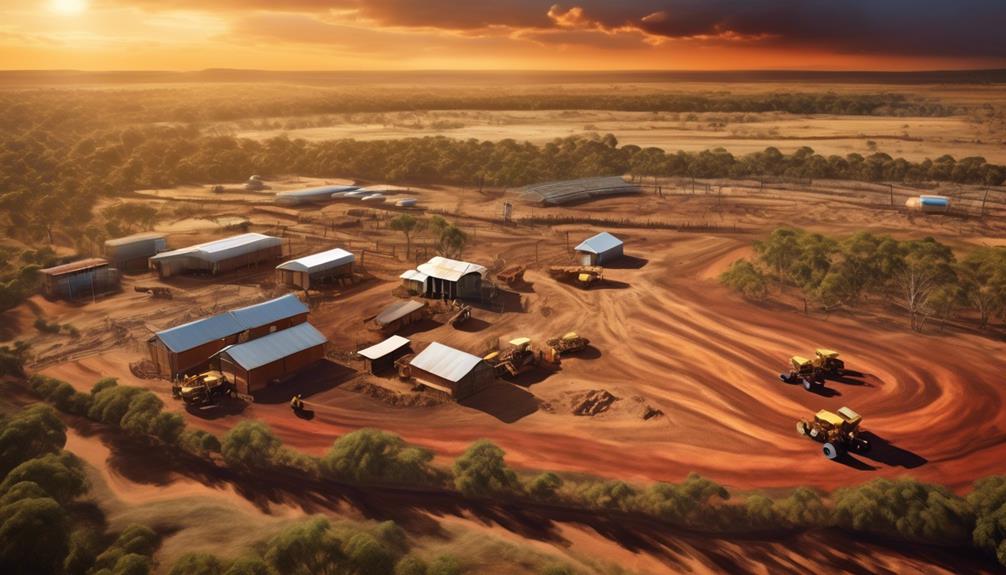
Mining and agriculture have profoundly altered the traditional lands of Aboriginal Australians, impacting their way of life and relationship with the environment. The expansion of mining activities and agricultural practices has led to significant environmental degradation, resulting in the loss of biodiversity, pollution of water sources, and destruction of culturally significant sites. Aboriginal communities have experienced economic exploitation as their lands are often targeted for resource extraction without adequate consultation or fair compensation. The disruption caused by mining and agriculture hasn't only affected the physical landscape but has also eroded the spiritual and cultural connection that Aboriginal Australians have with their ancestral territories.
The environmental impact of these industries has been a cause for concern, as it directly affects the livelihoods of Aboriginal communities who rely on the land for sustenance and cultural practices. Additionally, economic exploitation has perpetuated cycles of poverty and marginalization within these communities.
Addressing these issues requires a holistic approach that acknowledges the rights of Aboriginal Australians to their traditional lands and seeks to promote sustainable and equitable practices in the mining and agricultural sectors. By engaging in meaningful consultation and incorporating traditional ecological knowledge, it's possible to mitigate the adverse effects of mining and agriculture on Aboriginal lands and foster a more harmonious relationship between these industries and indigenous communities.
Contemporary Land Rights Movements
Given the complexities of contemporary land rights movements, understanding the various perspectives and stakeholders involved is crucial for fostering productive dialogue and sustainable solutions. Land rights activism and Indigenous sovereignty are key elements in the ongoing struggle for Aboriginal Australians to regain control over their traditional lands. This movement is characterized by a multifaceted approach that encompasses legal battles, political lobbying, and grassroots activism.
| Stakeholders | Perspectives |
|---|---|
| Indigenous Communities | Assert their inherent rights to land and self-governance. |
| Government | Balancing economic development with Indigenous land rights. |
| Non-Indigenous Citizens | Understanding and supporting Indigenous sovereignty. |
Land rights activism often involves challenging the historical dispossession of Indigenous lands, seeking legal recognition of traditional ownership, and negotiating agreements for co-management of natural resources. The concept of Indigenous sovereignty underpins these movements, emphasizing the right of Indigenous peoples to govern themselves and control their traditional territories. By acknowledging and respecting these principles, sustainable solutions that honor the rights and aspirations of Aboriginal Australians can be achieved.
Frequently Asked Questions
What Were the Traditional Land Management Practices of Aboriginal Australians Prior to European Colonization?
Traditional land management practices of Aboriginal Australians included controlled burning, hunting, and gathering, which sustained the land and promoted biodiversity. These cultural practices were deeply connected to the land and ensured its health.
However, with the arrival of European diseases, Aboriginal populations rapidly declined, impacting their ability to maintain these practices. This population decline, along with the loss of their land, disrupted their traditional land management and had lasting effects on the environment.
How Did the Introduction of European Diseases Impact the Aboriginal Population and Their Ability to Maintain Their Land?
The introduction of European diseases had a significant impact on the Aboriginal population. It led to a decline in their ability to maintain their land and loss of resources. This, in turn, had profound effects on their cultural preservation and land ownership.
The diseases devastated communities and weakened their ability to protect their territories. As a result, Aboriginal communities became more vulnerable to colonization and land dispossession.
The consequences of these events have been far-reaching and continue to affect Aboriginal Australians today.
What Role Did the Australian Legal System Play in the Dispossession of Aboriginal Land?
In understanding the role of the Australian legal system in the dispossession of Aboriginal land, the missionary presence and land rights legislation played pivotal roles.
Missionaries influenced policies that marginalized indigenous land rights. Additionally, land rights legislation further eroded Aboriginal ownership.
The legal system, intended to provide justice, unfortunately contributed to the historical loss of ancestral lands.
Understanding these factors is crucial in addressing the ongoing impact on Aboriginal communities.
How Did the Arrival of Sheep and Cattle Impact Aboriginal Land and Resources?
The impact of agriculture, particularly sheep and cattle, on Aboriginal land and resources was significant. Indigenous resistance to this encroachment was met with force, leading to the dispossession of their land.
The introduction of these animals resulted in overgrazing, destruction of vegetation, and competition for water, all of which disrupted traditional hunting and gathering practices. This ultimately led to the loss of Aboriginal land and resources.
What Are Some Examples of Successful Land Rights Movements and Legal Battles That Have Resulted in the Return of Land to Aboriginal Communities?
Land rights movements and legal battles have led to the return of land to Aboriginal communities.
For instance, the Mabo decision in 1992 recognized native title, restoring traditional land management.
Another success is the handback of Uluru to its traditional owners in 1985.
These examples highlight the impact of the Australian legal system in addressing the dispossession of land and the importance of acknowledging and rectifying historical injustices.
Conclusion
In conclusion, the history of the loss of land for Aboriginal Australians is a complex and deeply troubling one. From early encounters with European settlers to government policies and the impact of mining and agriculture, the displacement and seizure of land has had a profound impact on Indigenous communities.
Despite this, contemporary land rights movements continue to push for recognition and restitution. It's clear that this issue is far from being resolved and remains a thorn in the side of Australian society.
